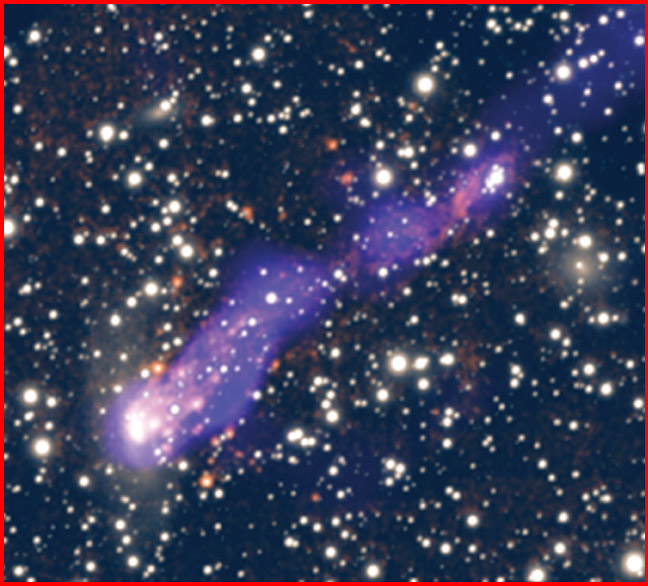
home •
about •
essential guide •
picture of the day •
thunderblogs •
news •
multimedia •
predictions •
products •
get involved •
contact
picture of the day archive subject index
Galaxy ESO 137-001 with its 200,000 light-year-long tail
Credit: X-ray: NASA/CXC/MSU/M.Sun et al; H-alpha/Optical:
SOAR (MSU/NOAO/UNC/CNPq-Brazil)/M.Sun et al
Sep 09, 2008
The Tail of a Galaxy
Glowing hydrogen ions and x-ray light illuminate this image of a galaxy more than 200 million light-years from Earth. The helical tail and point-source symmetry seem to indicate a plasma instability of truly astronomical proportions.NASA and the Southern Astrophysical Research Telescope recently announced the discovery of a galactic filament extending outward on a scale that has never before been observed. Said Ming Sun of Michigan State University:
"This is one of the longest tails like this we have ever seen and it turns out that this is a giant wake of creation, not of destruction." Her colleague, Megan Donahue agrees. "This isn't the first time that stars have been seen to form between galaxies, but the number of stars forming here is unprecedented."
It may be that the galaxy ESO 137-001 shown here is "plunging into" galactic cluster Abell 3627 and the speed of its passage may be "stripping gas" from it as it passes, but there is another force to consider that makes more sense of the observations than mere friction and gravitational interaction: electricity. As we have written in past Thunderbolts Picture of the Day articles about galactic filaments, the cause and effect being observed in the Chandra and SOAR images are the helical Birkeland currents that form when electricity flows through dusty plasma in space.
The "tail" in the above illustration was imaged in the wavelengths of optical light and x-ray emissions. According to the astronomers, newly created stars that have recently collapsed out of the hydrogen gas cloud that ESO 137-001 disturbed and compressed are producing the x-rays. Fusion has begun transmuting hydrogen into helium. As standard theory dictates, heat from gravitational compaction is more than enough to initiate the reaction.
It is because of stellar fusion theory that scientists have been spending 50 years and billions of dollars building arcane devices, trying to replicate the process they believe is taking place in stellar cores. The inherent difficulty with the attempt is the instabilities that occur in plasma, naturally.
Plasma under pressure and high temperature threatens to destabilize every microsecond. Some plasma toroid machines are trying to squeeze the beam of ions into a tightly confined, pencil-thin stream, so that it will sustain the temperatures necessary for atomic fusion. The problem that arises over and over again is akin to squeezing a bicycle innertube filled with air down into a smaller diameter.
Because the pressure cannot be evenly applied to the entire innertube all at once, little bubbles keep popping out of the tube's sidewall. The same thing happens in plasma-beam confinement. The plasma keeps "popping out" of its magnetic "bottle" and contacting the chamber walls, whereupon the fusion reaction stops instantly.
If the astrophysicists and astronomers would sit down together with electrical engineers and plasma physicists, they would understand that ESO 137-001 is exhibiting electric z-pinch effects because of the rotating Birkeland currents in the "tail". One of the hallmarks of plasma foci is that they glow in high-energy x-rays, gamma rays or ultra-violet, depending on how much current is available. They tend to form regions of extremely high density where the ions are actually forced together into "plasmoids" - doughnut-shaped bubbles that retain their individual shape.
Such a thing could also be happening at the greatest scale imaginable: clusters of galaxies thousands of millions of light-years in extent, forming gigantic whorls of energetic ions suddenly igniting with the force of a star.
Written by Stephen Smith from an idea contributed by Timothy Letendre
___________________________________________________________________________Please visit our Forum
The Electric Sky and The Electric Universe available now!

|
|

|
EXECUTIVE EDITORS:
David Talbott, Wallace Thornhill
MANAGING EDITORS:
Steve Smith, Mel Acheson
CONTRIBUTING EDITORS: Michael Armstrong, Dwardu Cardona,
Ev Cochrane,
C.J. Ransom, Don Scott, Rens van der Sluijs, Ian Tresman
WEBMASTER: Brian Talbott
Copyright 2007: thunderbolts.info
![]()
home •
thunderblogs •
forum •
picture of the day •
resources •
team •
updates •
contact us

